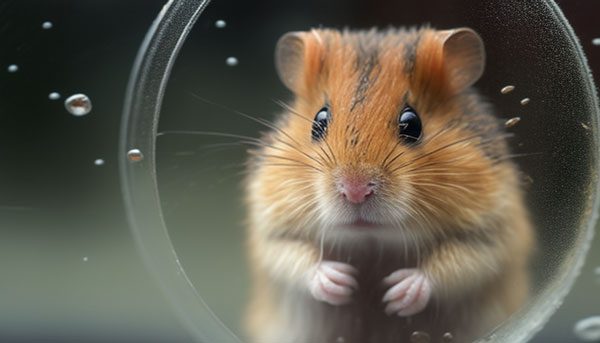Wet Tail in Hamsters: Causes, Symptoms and Survival Time
If you notice that your hamster has a dirty and wet behind it, it might have the wet tail disease. This illness is most common in baby hamsters around 3-6 months; however, it can also affect older hamsters.
So, what is wet tail in hamsters and what are the causes, symptoms, and survival Time? Wet tail, called Proliferative Ileitis, is a gastrointestinal disease resembling diarrhea. The main sign of wet tail is the hamster always has a wet behind due to the discharge coming from the anus. The survival rate is 2-3 days.
Hamster wet tail causes the hamster to become extremely weak due to dehydration. This guide will teach you everything you need to know about wet tail, such as their causes, symptoms, treatment, and prevention.
What Is Wet Tail In Hamsters, And What Causes It?
Wet tail, also known as proliferative ileitis, is a bacterial infection of the hamster’s digestive system. It is caused by a strain of bacteria called Escherichia coli and most commonly affects young hamsters. But it can also affect older hamsters who live in dirty environments.
However, the wet tail disease is different from diarrhea. Diarrhea can be caused by a hamster eating many veggies and fruits, but with wet tail is solely caused by harmful bacteria.

Wet tail is a severe and potentially fatal condition that spreads quickly, necessitating prompt veterinary treatment.
The survival rate of wet tail in hamsters varies depending on the severity of the infection and how long it has gone untreated. However, generally, the survival rate ranges from 2-3 days.
Here are the causes of wet tail disease.
- Stress: Hamsters are susceptible animals, which can lead to serious health issues like wet tail. Changes in the hamster’s environment, diet, or living conditions can all trigger the disease.
- Overcrowding: Because hamsters are solitary animals, they do not do well in crowded environments. Overcrowding can cause stress and increase the likelihood of disease transmission.
- Poor hygiene: Dirty cages and bedding can aid in disease transmission and increase the likelihood of a hamster developing wet tail.
- Weak immune system: Hamsters with a weakened immune system, such as those who are young, elderly, or sick, are more prone to developing wet tail.
- Gastrointestinal issues: Just like people, hamsters can also experience gastrointestinal problems. The rapid proliferation of bacteria in the stomach can cause wet tail, manifesting as diarrhea and a strong unpleasant odor.
- Here is a video to visually help you out.
Symptoms Of Wet Tail In Hamsters
Here are the symptoms of wet tail in hamsters:

Diarrhea
The watery and foul-smelling diarrhea is the hamsters’ most noticeable symptom of wet tail. Hamsters frequently have several loose or liquid stools in a single day. The feces’ consistency may be so thin that it resembles urine.
In severe cases, the hamster may become incontinent due to diarrhea.
Anorexia
Wet-tail hamsters may stop eating and drinking, resulting in rapid weight loss. In some cases, they may altogether refuse food and water. Anorexia can also lead to fatigue and depression.
Dehydration
Diarrhea caused by wet tail can result in significant fluid loss and dehydration. The hamster’s skin may become dry and inelastic, and its eyes may appear sunken. Dehydration, if left untreated, can be fatal.

Abdominal Pain
In hamsters, a wet tail can cause severe abdominal pain. When handled, they may hunch up or have a tense abdomen and show signs of discomfort or pain. In extreme cases, the hamster may cry out or show other signs of distress.
Depression and Lethargy
The hamsters may become less active and less interested in their surroundings, and they may sleep more. They may also become less likely to interact with their owners and less sensitive to stimuli.
Dirty Rear End
Due to frequent diarrhea, hamsters with wet tails may have a dirty rear end. The fur near their bottom can become matted and filthy, causing skin irritation and infection.
Thus, the skin may become raw and tender in severe cases, and the hamster may have difficulty walking or moving.
How To Treat Hamsters With Wet Tail?
Wet tail can quickly spread among hamsters and is frequently fatal if not treated promptly. Here are the steps for treating wet-tail hamsters:

Step 1: Consult A Veterinarian
A wet tail is a severe condition that necessitates immediate veterinary attention. A veterinarian can diagnose the situation and recommend the best course of treatment.
Antibiotics are the primary treatment for wet tail. Your veterinarian will prescribe an antibiotic to treat the infection and alleviate the diarrhea symptoms.
Step 2: Provide A Stress-Free Environment
Hamsters with wet tails require a stress-free environment. That is because stress can induce the bacterium that causes wet tail in hamsters to develop rapidly. Here are some suggestions on how to provide a stress-free environment:
- Be as quiet as possible when handling the hamster, and pick it up gently with two hands from below
- Provide a spacious enclosure with at least 6 inches of bedding
- Avoid making any loud noises or commotions in the hamster’s living space
- To mimic their natural sleeping conditions, turn off the lights in the hamster’s room at night
- To support the hamster’s overall health and well-being, provide a diet high in protein and fiber
Step 3: Isolating The Sick Hamster
If you have two hammies in the same cage, isolate the sick one because wet tail is highly contagious. Besides, feed the hamster small amounts of food daily to avoid dehydration.
Step 4: Observe The Hamster
Keep an eye on your hamster’s behavior and weight. If their behavior changes or they lose weight, it may indicate a more severe condition that necessitates further veterinary attention.
Step 5: Provide Electrolyte Solutions
Because hamsters with wet tails are prone to dehydration, it is critical to provide electrolyte solutions to replenish their fluids and minerals. Your veterinarian can advise you on the best electrolyte solution to use.
Step 6: Keep The Cage Dry
Because a bacterial infection causes wet tail, keeping the hamster’s cage dry is critical to prevent the bacteria from spreading. To prevent moisture buildup, clean the cage regularly and change the bedding frequently.
Also, do not wash the hamster’s behind. Instead, you can use a cotton ball to wipe the hamster’s tail or provide it with sand, which the hamster will use to clean itself. Sand lowers the risk of painful sores.
Step 7: Dietary Suggestions
Limiting the amount of wet or watery foods in the hamster’s diet is critical to help manage the symptoms of wet tail. This can aggravate diarrhea. Offer your hamster dry foods like well-formulated pellets.
Can I Prevent Wet Tail?
Yes, you can. Some of the ways we have already discussed in the section above include providing a stress-free environment, quarantining the sick hamster, providing a balanced diet, and good hygiene. Here are other additional points:

- One of the most effective methods of preventing wet tail is vaccination. Your veterinarian can recommend an appropriate vaccine and advise you on when and how often it should be administered
- Monitor a hamster’s behavior and its cage’s cleanliness before buying it; it can help detect signs of wet tail early
- Clean your hands before handling your hamster
After How Long Will The Hamster Be Cured From Wet Tail?
Recovery time can range from a few days to several weeks, depending on the severity of the infection. The good news is that hamsters can recover entirely from wet tail with prompt diagnosis and treatment. Antibiotics, fluids, and supportive care are common treatments.
In some cases, a hamster may take up to a month to fully recover from wet tail. If the hamster’s symptoms worsen or they stop eating or drinking, they should be taken to a veterinarian as soon as possible.

The most important thing to remember about wet tail is that prevention is critical. Keeping your hamster’s living environment clean, feeding them a nutritious diet, and monitoring their stress levels are all critical steps in preventing wet tail.
Hamsters are popular pets, but they are also prone to various health issues that can affect their well-being. If you’re wondering why hamsters fight or whether hamster bites hurt, we have the answers for you. Our article on why hamsters fight explores the possible reasons behind this behavior and what you can do to prevent it. Meanwhile, our article on whether hamster bites hurt provides insights into the pain level associated with these bites and how to prevent them. By reading these articles, you’ll be better equipped to take care of your pet hamster. So, go ahead and check them out!FAQs
Here are other related questions you may need to read for further knowledge.
Q: Can wet tail cause death to hamsters?
Yes, wet tail can kill hamsters. Wet tail is a fatal bacterial infection that can quickly spread to other animals in the same enclosure. If not treated within 2-3 days, your hamster will die.
Q: How much does wet tail treatment cost?
Because wet tail is a severe disease, expect to pay $50 to $250 to treat your hamster. This cost range covers everything from consultation, fluids, antibiotics, and specialized diet.
Q: Can wet tail recur in hamsters?
Yes. Hamsters can get wet tails multiple times, especially if they are in a stressful or filthy environment.
Conclusion
Wet tail is a severe condition that, if left untreated, can quickly spread and become fatal. As a hamster owner, you should be aware of the symptoms of wet tail and seek veterinary care as soon as possible.
A clean and stress-free environment, a balanced diet, and regular veterinary check-ups can help prevent and treat wet tail in hamsters. I hope you are now aware of the causes, symptoms, and survival rate of wet bottom to prevent and treat the condition.




